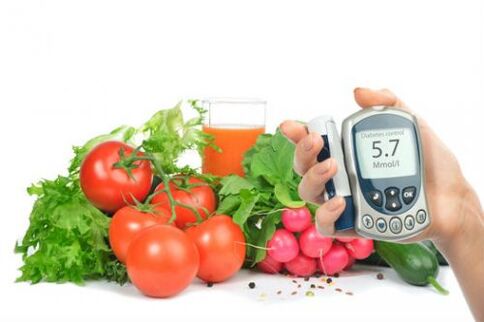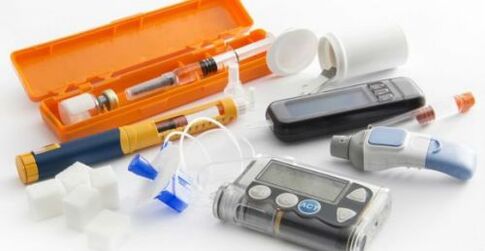Diabetes mellitus is a pathological condition characterized by a violation of metabolic (metabolic) processes. This occurs due to insufficient production of its own hormone insulin, as in the case of type 1 diabetes, or a violation of its effect on the body's cells and tissues (type 2 pathology).
The article discusses in detail the main types of diabetes mellitus, the differences in their causes and mechanisms of development, as well as describes the features of the treatment methods for the patient.
A little about insulin and its role in the human body
Insulin is a hormone produced by the pancreas. This organ is located behind the stomach, it is surrounded by the spleen and a loop of the duodenum. The weight of the pancreas is about 80 g.
In addition to hormones, the gland produces pancreatic juice, which is necessary for the digestion of lipids, carbohydrates, and proteins. The hormone insulin is synthesized by β cells. They are localized almost over the entire surface of the pancreas as small groups called islets of Langerhans. The islets also contain α cells that synthesize the active hormone glucagon. This hormone has the opposite effect of insulin.
A healthy adult has about a million of these small islands with a total weight of several grams.
Insulin is a protein molecule composed of several chains of amino acids. Its job is to assimilate glucose (sugar) by the body's cells. Sugar is necessary for a person to get energy. Without it, cells and tissues cannot fulfill their functions.
Along with the absorption of sugar, insulin also regulates the entry of amino acids into cells. Amino acids are considered as one of the main building materials. Another function of insulin is the accumulation of lipids in the body.
Classification of diabetes
According to the commonly accepted and used classification of diabetes mellitus in modern endocrinology, pathology is divided into the following categories:
- Type 1 - insulin dependent (IDDM);
- type 2 - non-insulin dependent (NIDDM);
- pregnancy form;
- specific types of diabetes.
The second option is a group of conditions that differ in their pathogenesis and developmental etiology. These include genetic defects at the genetic level on part of the insulin hormone or insulin-secreting cells, diseases caused by the effects of chemicals and drugs, diabetes caused by infectious processes, and more. v.
All types of diabetes are united by elevated blood sugar. This is a condition that is manifested by an elevated level of glucose in the blood. Confirmation or rejection of the diagnosis of diabetes is based on the diagnosis of blood glucose counts.
1 Category
Pathology type 1 (ICD-10 code - E10) is considered an autoimmune process, which leads to the death of insulin-secreting cells. In a word, such processes are initiated in the human body, in which their own immune cells treat pancreatic cells as foreign and destroy them.
As a rule, the type of insulin dependence arises due to genetic predisposition, but concomitant predisposing factors also play an important role. Statistics show that the presence of pathology in children can occur in the following cases:
- if the mother is sick - with a frequency of 2%;
- sick father - 5%;
- sick brother, sister and brother - 6%.

If one of the relatives has the disease, the rest of the family can stay healthy, even though they are at high risk for the disease.
The presence of an autoimmune process, i. e. antibodies in the body to the cells of the pancreas, occurs in more than 80% of insulin-dependent patients. Often, along with type 1 disease, diabetics have other autoimmune diseases, for example, chronic adrenal insufficiency, pancreatic disease, vitiligo, rheumatism.
How is it developing?
Typically, clinical signs of disease appear when more than 85% of the insulin-secreting cells have died, but depending on the individual characteristics of the organism, this period can vary. Usually occurs in childhood and adolescence. It occurs when young patients become aware of the presence of the disease already at the stage of acute complications, for example, in a ketoacidotic state.
The lack of energy and lack of insulin lead to a large breakdown of fats and proteins, which explains the patient's weight loss. High blood sugar causes an intense phenomenon, which manifests itself as overproduction of urine and the development of symptoms of dehydration. Since there is not enough insulin, the body is starved for energy, so there is an over-synthesis of the opposite hormones, which are hormones that have the opposite effect of insulin's action.
These hormones include cortisol, glucagon, and somatotropin. They cause stimulation of the formation of glucose in the body, despite the fact that the blood sugar level is already high.
Mass breakdown of fats leads to an increase in the number of free fatty acids in the blood. This is the agent that causes the formation and accumulation of ketone bodies (acetones), which become the stimulants of the sexual ketone state. If such a pathological condition, dehydration and pH conversion of the blood to acid continue to progress, the patient may fall into a coma, possibly even death.
Symptom
Type 1 diabetes is characterized by the development of bright, worsening symptoms over several weeks. Diabetics complain:
- for the formation of a large amount of urine;
- thirsty;
- persistent skin itching;
- weight loss.
Manifestations of the disease are considered quite specific, but still need to make a differential diagnosis.
Weight loss, accompanied by normal or increased appetite, is one of the symptoms that distinguishes type 1 pathology from other types of diabetes. Patients are worried about physical weakness, can not do their usual work, drowsiness occurs.
The clinical course of the disease is accompanied by the appearance of an odor of acetone in exhaled air, abdominal pain, nausea and vomiting, and symptoms of severe dehydration. If the disease appears at a later age (about 40 years), the symptoms are not so pronounced, and as a rule, the presence of the disease is determined during the clinical examination.
type 2
Non-insulin-dependent diabetes mellitus (ICD-10 code - E11) is a chronic disease in which high blood sugar occurs due to insulin resistance. Subsequently, the activity of the β cells of the islet of Langerhans was also disrupted. In parallel with carbohydrate metabolism, pathology also affects fat metabolism.
Heredity is one of the main causes of type 2 diabetes. If one of the parents has the disease, the children get it in 40% of the cases. However, genetics alone is not enough, the provoking factors are:
- high body weight;
- little physical activity;
- high blood pressure numbers;
- high levels of triglycerides in the blood;
- the presence of a child born weighing more than 4 kg in the past;
- the presence of gestational diabetes in the past;
- Polycystic Ovary.
The number of patients with type 2 diabetes is increasing day by day. This form of disease accounts for more than 85% of all clinical cases. Men and women who are middle-aged and older are more likely to get sick.
How is it developing?
The mechanism of development is based on the emergence of insulin resistance, that is, the pancreas produces enough of the hormone needed to transport sugar molecules into the cells, but the cells themselves lose their sensitivity to this substance. The result is an increase in blood sugar.
To lower blood sugar, the gland starts working to the limit of its capacity. This causes a decline in insulin-secreting cells.
For the second type of pathological condition, the occurrence of ketoacidosis is not specific, since even a small amount of the hormone is synthesized by the islets of Langerhans.
Symptom
The disease usually presents in patients over 40 years of age. In most cases, the clinical picture is associated with the appearance of pathological body weight, changes in fat metabolism in blood tests. Associated symptoms:
- performance is slightly reduced, but this is not as pronounced as in the first type of disease;
- pathological thirst;
- excrete a large amount of urine;
- women may be bothered by itchy skin in the genital area and perineum;
- skin rash that does not heal for a long time;
- discomfort, numbness and goosebumps in the lower extremities.
Pregnancy type
The WHO classification of diabetes includes the form of gestational disease (ICD-10 code - O24). It is typical for pregnant women. Diabetic 5-7% of patients give birth. The WHO classification of diabetes and its types includes another name for this type of pathology - diabetes in pregnant women.
If the disease appears in a woman before the time of conception of a child, it is considered pregnancy, during pregnancy - pregnancy. At present, the mechanism of development and etiology of the disease is not fully understood. There are data on the role of genetic predisposition. Possible risk factors are:
- physical and mental trauma;
- Infectious Diseases;
- diseases of the pancreas;
- Include in the menu a large number of foods rich in carbohydrates.

Obstetricians and gynecologists agree that adequate physical activity can reduce the risk of developing the disease.
Gestational morphology can manifest itself as a manifestation, that is, a vivid clinical picture, or as a violation of glucose tolerance. Pathology, as a rule, goes away on its own after the child is born.
The woman becomes part of a high-risk group of patients with non-insulin dependent diabetes over the next 10-15 years.
During pregnancy, a woman's body undergoes certain changes related to the hormonal sphere. This is due to the function of the placenta, which secretes the following hormones:
- chorionic gonadotropin;
- progesterone;
- female hormones;
- corticosteroids, etc. v.
All these hormonally active substances cause the appearance of insulin resistance. At this stage, the proliferation of insulin-secreting cells and the release of a large amount of insulin into the blood is observed from the pancreas. The appearance of insulin resistance leads to the fact that the woman's body begins to actively use the metabolic products of fat, while sugar is stored for the nourishment of the fetus. In conditions where there is a combination of the genetic factors of diabetes and the above factors, the disease develops.
Symptom
The pregnancy form presents like other forms of diabetes, but the symptoms are somewhat less pronounced. A woman may not notice the symptom, associating its appearance with her "interesting" position. If the clinical picture is clear, the pregnant woman may present the following complaints to the attending physician:
- Dry mouth;
- want to drink continuously;
- excrete a large amount of urine;
- increased appetite;
- performance loss and weakness;
- itching and burning in the genital area.
Importance! Usually the disease develops at the end of the second or the beginning of the third quarter.
Effects of disease on mother and fetus
Chronic hyperglycemia negatively affects both the mother's body and the child's own. Pregnancy can be complicated:
- polyhydramnios;
- late pregnancy;
- termination of pregnancy at different stages of pregnancy;
- giving birth to a child with a large body weight (more than 4-4. 5 kg).
Babies born to a sick mother have a characteristic appearance. Their shoulders are quite broad, the subcutaneous fat is prominent, and their faces are shaped like a full moon. There is significant skin swelling and hyperpigmentation. The most severe complications of the disease are stillbirth during fetal development and infant death. As a rule, such conditions occur when there is a form of pregnancy disease.

Babies born to a sick mother differ from their peers in their large body weight and characteristic appearance.
Specific types
We are talking about secondary forms of pathological conditions that develop under the influence of chemicals, drugs, infectious processes and other diseases of the endocrine and exocrine spheres.
Diabetes can be caused by the following diseases and conditions of the pancreas:
- visceral inflammation;
- mechanical damage;
- removal of glands;
- cancer;
- cystic fibrosis;
- pigmented cirrhosis, v. v.
Among the chemicals and drugs, nicotinic acid, adrenocorticotropic hormone, interferon, thyroid hormone and diuretics may contribute to the development of the disease. The list continues with opiates, rodent poisons, antidepressants, antiretroviral drugs.
Among infectious agents, the provoking factors are rubella virus and cytomegalovirus.
Features of treatment
Therapy for the medical condition is selected individually for each clinical case. The program and treatment method used depends on the degree of diabetes, the type of disease, the brightness of the clinical picture, and the presence of complications. How to identify and confirm the presence of the disease, a qualified endocrinologist will tell you. He will give guidance on the following diagnostic methods:
- general blood and urine tests;
- capillary blood analysis for glucose from the finger on an empty stomach;
- blood chemistry;
- urinalysis for sugar;
- glucose tolerance test - mandatory for all expectant mothers in the period from 22 to 26 weeks of pregnancy;
- Determination of indicators of glycosylated hemoglobin.
Treatment measures include not only medication, but also physical therapy exercises, nutritional adjustment, and patient self-control.

It is important that the loved one is supportive in the patient's desire to reduce the aggressiveness of the medical condition and achieve compensation.
control yourself
Diabetics should keep a record of sensations, blood sugar, and urine sugar, as well as record data on their individual menu and physical activity for the day. The aggregate of those indicators and their accounting is self-controlled. The purpose of such events is not only to control sugar levels, but also to interpret the results, as well as to plan their actions should the numbers go out of an acceptable range.
With normal health, it's important to measure sugar levels at home and record these readings at least once per day. Any change in the state of health requires clarification of the amount of glucose in the blood several times a day:
- before each main meal;
- some time later food enters the body;
- before the evening rest;
- In some cases, you may need to measure in the morning on an empty stomach.
Urine glucose is also measured at home. This requires the presence of an express band. They can be purchased at pharmacies. The presence of sugar in the urine will indicate that the blood glucose level exceeds 10 mmol/l, as this number is the renal threshold at which glucose molecules enter the urine.
If the patient is traveling, actively participates in sports, or has any comorbidities, more rigorous self-monitoring will be required.
For the comfortable everyday life of a person with diabetes, it is necessary to purchase the following personal devices and tools:
- blood glucose meter with lancet, test strips and necessary accessories included;
- rapid urine line, measuring the body's level of acetone and sugar;
- manometer to clarify blood pressure numbers;
- Self-control log where all necessary data will be recorded.
Dish
Individualized nutritional adjustments are the basis for the treatment of any type of diabetes. With type 1, changing the individual menu allows you to reduce the load on the pancreas, reducing the amount of carbohydrates supplied to the body. In type 2 diabetes, a low-calorie diet can not only achieve the above goals, but also reduce pathological body weight.

The patient should observe table number 9, which may have several options (a, b, c).
Patients must strictly adhere to the daily calorie intake. It is calculated individually for each patient, depending on weight, age, sex, energy expenditure, physical activity, drug therapy used. In the patient's diet, it is necessary to limit the intake of high-carbohydrate, high-calorie foods. Protein is not only there but also necessary, fat should be limited a bit, especially with type 2 disease.
The patient will have to understand the bread unit system, the product's glycemic index and insulin, and calories. Features of the principles of nutrition:
- do not eat more than 8 units of bread in one meal;
- sweet liquids (lemonade, sweetened tea, store-bought juice) are prohibited;
- instead of sugar, sweeteners are used, and instead of store-bought juices, homemade juices and juices are used;
- The number of bread units must be planned in advance, as insulin is used before the product enters the body;
- meals should be divided into small, but frequent portions;
- the patient should receive adequate fluid infusion - limitations may arise in the case of renal failure or other complications associated with edema.
You can read more about prohibited foods, as well as those that should be consumed without fear, in the table.
| Foods with the highest calorie content to limit | Products are allowed | Permissible amount of alcohol (under conditions of use - below) |
|---|---|---|
|
|
|
The possibility of drinking is discussed separately. A small amount is allowed if there is compensatory diabetes mellitus, no complications, the patient feels normal. Beer and sweet cocktails are prohibited.
Medical treatment
Treatment of IDDM and pregnancy form is based on insulin therapy. This is the process of introducing insulin-based hormonal preparations to replace the deficiency of its own substance in the body. There are several classes of drugs that differ in duration of action and rate of onset of action: ultrashort-acting preparations, short- and intermediate-acting hormones, and long-acting insulins.
Usually, doctors combine two drugs with different duration of action at the same time. This is necessary to create the best physiological conditions for the pancreas.

The medication is administered using an insulin syringe, injector pen, or using an insulin pump in automatic mode.
Type 2 disease requires the use of oral hypoglycemic tablets. The main groups are biguanides, sulfonylurea preparations, thiazolidinediones, glinides, etc. v.
The differential diagnosis of diabetes mellitus should only be performed by a qualified specialist. He will also help you choose an optimal regimen and lifestyle and make recommendations that will allow the patient to achieve compensation as quickly as possible.


























